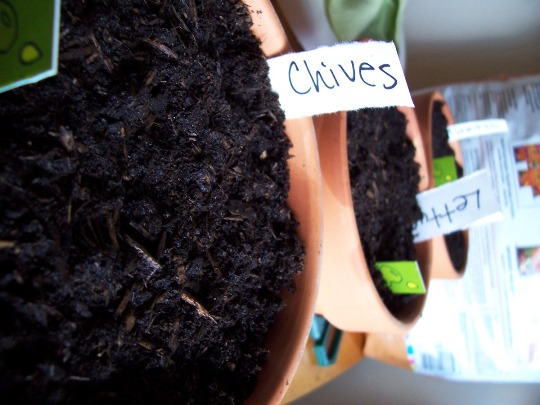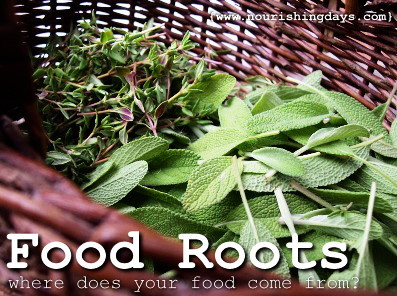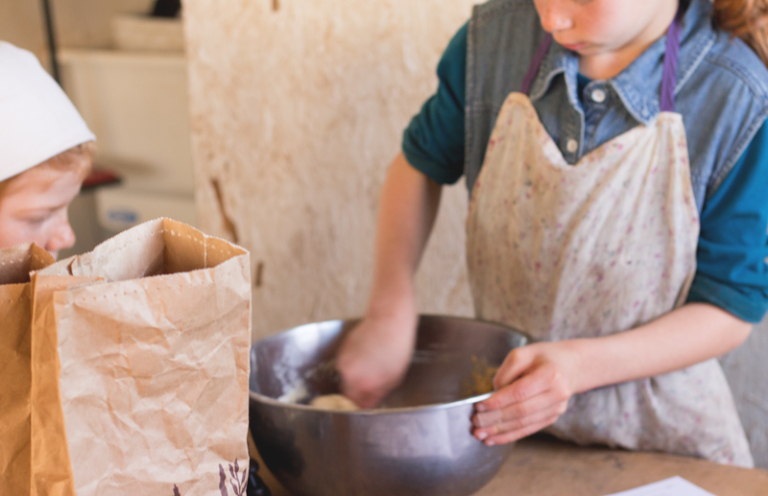Experimenting with Growing Food Indoors

We put our garden to bed a couple of weeks ago by planting garlic in our tomato beds and more recently mulching with great numbers of leaves. It was kind of sad when I realized that it was over for the year. I am still so new to this plant-grow-harvest-eat concept that I keep asking myself "why don’t we just grow things inside when it gets cold?"
Am I naive?
Why Bother?
Last week I gave you my motivation for spending the time to grow our own food when I closed out Food Roots. Here are a few reasons I want to try growing something inside this winter:
- It saves money. Having herbs, greens, onion, or garlic scapes on hand may seem small, but it’s a frugal way to spice up simple peasant foods like soup and beans.
- It’s another excuse not to buy something from the store. The more I focus on locally grown and homegrown foods, the more difficult it is for me to justify buying things from large grocery stores. Especially if they can be grown at home.
- It helps clean your air. Having indoor plants of any sort is helpful to the air in your home, especially during the stuffed up winter months.
- It beautifies your home. I love how edible plants are multi-taskers in that they are both beautiful and delicious.
Keeping It Simple
I have read books on what you can grow with expensive, energy-sucking grow lights. That is not what I am going for here. I simply want to take advantage of the sun we get through our windows, and at the most create make-shift cloches out of milk or vinegar jugs. Simple.
So I am giving it a shot. Here is what I have started and have planned:
- Chives, cilantro, and lettuce – planted in organic potting soil.
- Thyme, parsley, and sage – in pots brought in from outside.
- Garlic Scapes and Green Onions – A simple-looking project I received in my inbox from Organic Gardening Magazine.
Indoor Compost
I have also been establishing an indoor compost bin since mid-summer. It is unbelievably easy – simply feed the worms a few times per week and adjust their bedding as needed with leaves, grass-clippings, or paper. It is contained in a large rubber bin located in my laundry room and best of all it doesn’t stink.
I plan on using this compost to make a tea for feeding my indoor plants this winter. If, when spring arrives, our little worms have reproduced as they are supposed to I should have enough on hand to add to our outdoor compost, which I am told should speed things up nicely.
As you can tell this is all new to me. Mostly experimental, this indoor garden of sorts is going to be a learning experience. Which is where you come in…
Can you tell me anything about growing food indoors? What have you grown and what methods worked for you? Am I just being naive?
Stephanie is hosting her annual organic gardening carnival in case you are looking for more musings on gardening. This post is also a contribution to Fight Back Friday and Frugal Friday.






I have no tips to offer. I can’t even grow house plants without them dying. But I’m excited to see what you do.
For the compost bin/worms. Is the bin kept covered or is it an open bin? Did order a starter kit or make it yourself?
We just took a trip to my SIL’s new apartment, and she has basil and rosemary growing already – they smell great! Plus it looked really easy (and they look attractive sitting on the coutertop, too). It got me thinking about growing my own. Buying non-irradiated and organic spices can be so expensive, but growing them sounds fun! I will have to try this soon.
Question: we don’t get a lot of direct sun in my home – will this hinder my efforts to grow herbs?
Heavens no, you’re not being naive. I’ve had plants inside in winter for several years now. In my kitchen window well I have chives and parsley. In my small attached greenhouse I have four celery plants and two large parsley plants. They stay out there until it gets really cold, and then I move them to a window sill in our walk-out basement.
I’ve got some growing things still out in the garden. There’s kale, which will hold until it gets quite cold, and mache, which will stay green even buried in a snow bank.
I love that you’ve been growing indoors! I would like to try that myself. Since I’ve got my big garden, I don’t really, but I definitely miss my fresh stuff all winter. Maybe some greens or herbs this year?? Now you’ve got me thinking!
I also worm compost, and find it so incredibly easy! I wish I had started doing it before!
Thanks for joining in the carnival! It’s nice to have someone share about a different style of gardening! 🙂
I’m with Millie…I cannot for the life of me keep house plants alive! Not sure why. I hope it works for you. I’d love to pot up some of my culinary herbs and bring them in for the winter. The last time I did they died.
Bringing plants in is different then starting new from seeds. When bringing in they can have little buggies and you’ve got to treat them…..I guess that’s where I went wrong. Oh well. My low tunnel hoops are good enough for me to keep me gardening at least until January in Maryland.
You’ve got my wheels turning, too. I’m also new at all this and wonder, is the sun through a window nourishing *enough* as it is outside? It must be, since some things do grow well on window-sills…Hmmmmmm
Seeing our empty garden makes me so sad, this would perk me up for sure!
I love this idea of growing indoors! I’ve thought and thought about how I could do it. But I doubt it would work since I keep my house around 65 during the day and 58 at night. I just don’t think anything would grow.
I will do sprouts in the microwave though. I’ll leave the light on and put a hot water bottle in there. I’ve done this in the spring and it worked. I’ll try it in the dead of winter when it’s really cold. I’ll also ferment veggies this winter and see how that goes. I bought a couple cheap coolers. I’ll put the veggies in the cooler with a couple hot water bottles (I’ll change the water bottles at least two times a day.) I’m going to get some goodwill towels and wrap the jars too. I’m hopeful that these two things will work this winter!
Tina – I love the sprouts in the microwave idea! I’m always interested in new ways I can use that appliance which has become otherwise useless since I stopped zapping food with it earlier this year!
Awesome idea- especially the lettuce…. I would LOVE to grow lettuce inside!
We tried to grow basil and a few other herbs from seed… and found out that basil should be grown by itself- guess it’s a take over type of herb. It killed all the others in the planter. The mint survived in it’s separate planter though! I haven’t used any of it for cooking as the leaves are kinda small, but it’s alive which is fun.
Yep, totally got me thinking on planting some lettuce and perhaps chives… 🙂 Can’t wait to see what happens!
Ginger, too! At least, I hope. I planted some sprouting ginger in a pot and it is doing great. I hope I can harvest the rhizomes eventually. But the shoots are so healthy inside (in the bathroom)!
My mother has alot of veggies growing in her basement under full spectrum light bulbs. I have always wondered if that artificial light is as nourishing as the sun. I will have to ask her more about her techniques. I have to admit, she does have the worlds most gorgeous basement, its quite tropical.
I learned about growing buckwheat lettuce indoors from a wonderful, resourceful friend!! You sprout them and then plant them in a couple of inches of organic dirt (in a 9×12 baking pan works great!), cover them with plastic wrap until they are busting out, mist them and voile! Edible greens with delicate flavor! The only drawback is the hulls popping off and leaving a mess on your floor! You can cut them down once and let them grow back, harvest and then throw the root mat into your frozen garden. In the spring they just disintigrate; they are the easiest compost material!!! Enjoy!
I don’t think our house has enough light, and that’s the only thing I could think that would restrict your ability to grow inside.
It takes planning in the fall, but we love a book called Four Seasons Harvest. It talks about green houses and growing under tunnels for the winter. We have pretty mild winters in Oregon, so it’s not hard, but the author lives in Maine! If you haven’t seen it before, it’s definitely worth checking out.
Just found your blog, and am really enjoying reading it!
Thank you for the great article. Would you please do an article about your indoor composting. I would like to see pictures also if you do not mind. I was ready to buy an expensive composter, but now I have that on hold.
I’ve not read every post here yet, so maybe I’m being redundant, but here’s a tip:
Did you know you can grow celery inside? When you buy and use a stalk of celery from the store, but the ribs all at the same time about 2 inches above the bottom of the stalk. Sit this 2 inch remaining stalk in water (We used a few toothpicks stuck into only the outer ribs to hover it over a dish of water). Amazingly, new ribs grow. You can plant this when it has some roots and continue to grow it. With this in mind, I’ve done the same thing with Romaine lettuce bought from the store. It’s early in the experiment but I’m seeing new leave growing (they are tiny so far, but definitely showing growth). I’ve been told the same thing could happen with pineapples (cutting the top off and starting the new plant from it) but that it takes a couple years to start getting a return. Also, I intend to grow a sweet potato in a bucket to see if it will produce a crop indoors. Not sure if it will, but in theory, I think it should if it is warm enough and sunny enough indoors.
*not “but the ribs” – cut the ribs instead.